A research investigation entails systematic collection of data, careful analysis of the data collected and finally use of the findings to make inferences about the population set. In this case, it would involve the collection of data for various aspects of education such as methods of teaching, how students learn, the dynamics of a classroom, and effectiveness of teacher training. This research investigation, like any other, must be rigorously and systematically done with the use of the scientific approach. Methods employed in an educational research investigation may be drawn upon other disciplines such as psychology, anthropology, sociology and even philosophy. A research investigation in education attempts to solve existing problems. It involves the gathering of data which usually is either primary or secondary. Primary data is data collected from first-hand sources whereas secondary data is obtained from secondary or already existing sources such as books (Cobb et al., 2003).
This paper makes use of the scientific approach in examining research methods necessary when conducting an educational research investigation. The Scientific approach manipulates variables through the use of direct questions and carefully designed procedures to obtain information intended to give answers to the questions raised. There are two types of data: qualitative and quantitative data. Qualitative data refers to data that is of descriptive nature and analysis of this kind of data is qualitative research. The qualitative research employs the following tools: observation, analysis of documents, conducting interviews on the study variables, analysis of products such as diaries and journals. Qualitative reaches include historical research, case studies, narrative studies and phenomenological studies (Smith, 2015).
Quantitative data, on the other hand, refers to data that is numerical; this study, therefore, is referred to as quantitative research and is based on the assumption that numbers singly describe reality. It uses statistical analysis to obtain interrelationships of variables. Quantitative researches include experimental, descriptive, correlational analysis, causal-comparative analysis, and meta-analysis (Hartas, 2015).
Quantitative research increases the credibility of the findings and conclusions made as it makes use of statistically valid random sample variables which are used in generalizations and to determine patterns and correlation of variables. Besides, the reliable recurring information from says quantitative surveys provide a trusted set of statistics which provide significant accuracy in forecasting and planning (Hartas, 2015). Qualitative research through in-depth questioning and close observations provides insights into the underlying reasons of the study population explaining motivations and opinions of individual behaviors. Qualitative research, therefore, is critical in uncovering problems facing the population and eventually revealing existing trends.
Quantitative research is easy and quick as researchers test hypotheses using the statistical analysis and makes a generalizing conclusion for the entire population. However, statistical analysis may fail to provide specific details which might be important in the study being carried out. This is because it is characterized by limited ability to probe answers. Qualitative research on the other hand despite providing a richness of information that may evade quantitative analysis is susceptible to researcher bias and personal subjectivity (Hartas, 2015). Moreover, qualitative research findings cannot be generalized because every individual has different answers to say interview questions. Besides, its small sample sizes make it difficult to generalize findings.
Conclusion
To improve the accuracy and quality of data collected, the two research approaches are brought together often referred to as mixed research method. This approach is essential as it enriches the findings by identifying problems and uncovering information that may otherwise be lost in a quantitative approach. It examines and produces a better explanation of conclusions based on statistical findings and qualitative findings. Combining both methods, therefore, generates results-driven findings reflecting the entire population. Moreover, it provides more in-depth insight into the questions being studied (McCusker et al., 2015)
References
Cobb, P., Confrey, J., DiSessa, A., Lehrer, R. and Schauble, L., 2003. Design Experiments in Educational Research. Educational Researcher, 32(1), pp.9-13
Hartas, D. ed., 2015. Educational Research and Inquiry: Qualitative and Quantitative Approaches. Bloomsbury Publishing
McCusker, K. and Gunaydin, S., 2015. Research Using Qualitative, Quantitative or Mixed Methods and Choice Based on the Research. Perfusion, 30(7), pp.537-542
Smith, J.A. ed., 2015. Qualitative Psychology: A Practical Guide to Research Methods. Sage
Cite this page
Quantitative Research Investigation Paper Example. (2022, Jun 19). Retrieved from https://proessays.net/essays/quantitative-research-investigation-paper-example
If you are the original author of this essay and no longer wish to have it published on the ProEssays website, please click below to request its removal:
- English Pronunciation Challenges Among Second Language Learners
- The Fatal Surfing Incident
- The Finance Analysis With Respect to Possible Consolidation
- Personal Statement for Nursing School
- How Sports Affect Children - Research Paper
- Essay on Young Adults Experiencing Major Life Milestones Later Than Their Parents
- Essay Example on Radburn: Unresolved Issues Affecting Teamwork and Progress







